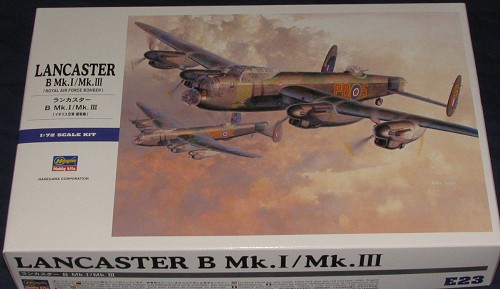
| KIT: | Hasegawa 1/72 Lancaster I/III |
| KIT #: | 00553 (E 23) |
| PRICE: | $59.98 MSRP |
| DECALS: | Three options |
| REVIEWER: | Scott Van Aken |
| NOTES: | You can give your Matchbox kits to your kids. |

| HISTORY |
The British successfully operated three four engine bombers during WWII; the Sterling, Halifax and Lancaster. The Sterling was limited somewhat by its short wing span due to a silly requirement that it fit into existing hangars. The Halifax had a somewhat long development, but eventually turned into a very good bomber. The Lancaster began as the twin engine Manchester, but problems with the Manchester's two Vulture engines had them replaced with four Merlins and the rest it history.
Undoubtedly the most successful of the three, the Lancaster bore a great deal of the RAF's night bombing campaign from mid-1943 until the end of the war. Many were successfully sold overseas and operated by Argentina, Canada and Egypt, to name a few. This particular kit is the Lancaster I/III, differentiated only by the fact that the Merlins in the Lancaster III were made in the US by Packard.
| THE KIT |
 Molded in
Hasegawa's usual medium grey plastic, this is a very typically done kit.
Panel lines are nicely engraved, there is a fairly good cockpit with decals
for instruments, wheel wells are done fairly well and it comes with a full
bomb load. Conversely, you can have the doors shut on this model if
you don't want to mess with all the bombs. Not using the bombs will
undoubtedly reduce the near 250 parts needed down to something like 175.
The kit offers two different noses and two different types of prop,
depending on the aircraft you are modeling.
Molded in
Hasegawa's usual medium grey plastic, this is a very typically done kit.
Panel lines are nicely engraved, there is a fairly good cockpit with decals
for instruments, wheel wells are done fairly well and it comes with a full
bomb load. Conversely, you can have the doors shut on this model if
you don't want to mess with all the bombs. Not using the bombs will
undoubtedly reduce the near 250 parts needed down to something like 175.
The kit offers two different noses and two different types of prop,
depending on the aircraft you are modeling.
Other
little bits and pieces are also markings dependent, with the instructions
telling you just what to use. One type, for instance, has a ventral turret
while another uses the H2X radar system. Though standard exhaust are on the
trees, all three versions use the flame dampers. To aid with construction,
wing spar stubs are part of the interior so will help when it comes to
attaching the wings. The clear bits are well done and optional cockpit side
windows are provided, with one set having tear drop shaped bulges. Clear
bits are used for the wing tips as well (you have to cut the molded ones
off), and there are seemingly a zillion little side windows. Those of you
skilled in the use of Krystal Klear may want to use that substance to
replace all these tiny windows.
Instructions are very well done with the usual Gunze color calleouts. They correctly show the wheel wells, bomb bay, and parts of the cockpit in "semi gross black" (undoubtedly part of the monster paints collection....). All three aircraft are from 467 Squadron at various times during 1943/44 and all are in Dark Earth/Dark Green over Black. Decals are very well printed and look to be of the 'new' type as the reds and whites seem to be the proper shade.
| CONCLUSIONS |
There have been a lot of us who have been looking forward to this kit. It sold like hotcakes at the Nationals and it will be interesting to see what other variants Hasegawa can squeeze out of this one.
July 2005
Review kit bought on the open market by me.
If you would like your product reviewed fairly and quickly by a site that has around 300,000 visitors a month, please contact me or see other details in the Note to Contributors.